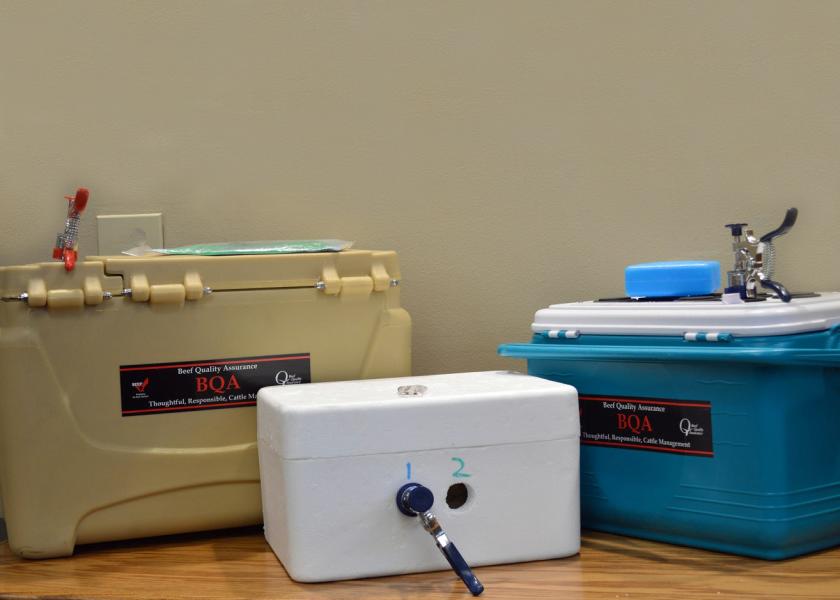Chute-Side Cost Savings

A strong vaccination program can have a sizable impact on a herd, both in dollars spent and on the herd’s health. We expect a vaccine to protect animals from detrimental health problems due to infectious diseases. Given the importance of vaccines in an animal health program, proper handling is vital to ensure the product remains effective. Improper handling can render the product useless.
It’s important to buy vaccines from a reputable business. A good distributer will maintain a temperature log for their cooler to confirm vaccines are handled properly prior to selling. When buying vaccines locally, ask about storage conditions and use a cooler with ice packs to transport the vaccine home. Shipped purchases should have sent overnight, upon arrival, check the temperature of the shipping cooler. If the temperature is above 45°F, contact the distributer and arrange to have the vaccine replaced.
Vaccines should be stored at temperatures between 35-45°F and protected from ultraviolet light. Although killed vaccine products are considered more stable than modified live products, both are susceptible to degradation if exposed to temperatures outside this range. Freezing is most detrimental to killed vaccine products; it will change the structure of the adjuvant, which is the part of the vaccine that presents the antigen to the immune system. Additionally, freezing may release toxins that are normally bound by the adjuvant. Although killed vaccines are fairly tolerant to warmer temperatures, exposure to temperatures above 45°F for longer than one hour is not recommended. Modified live vaccines are fragile after they have been mixed; they should be kept between 35-45°F and used within two hours. Vaccines that have undergone temperature cycles above or below the recommended storage temperature will have reduced efficacy and may be completely worthless due to deactivation.
Another important factor to consider is the vaccine’s expiration date. Vaccines are approved by the USDA to meet an efficacy standard. Over time, the efficacy of a vaccine will decline. The vaccine manufacturer has determined the timeline from the date of production to critical loss of efficacy to establish the expiration date. To reduce the risk of a vaccine becoming outdated, buy only enough vaccine to meet immediate needs.
The final hurdle to keeping a vaccine viable is during the time of use. The size of an operation will determine the length of time a vaccine is exposed to environmental conditions. Good planning will assure the vaccine retains its efficacy and results in immunized livestock. Vaccines should be transported to a working facility in a rigid sided cooler that has been pre-cooled. It will take about an hour for a large cooler at room temperature to cool down to 35-45°F. Additionally, a smaller pre-cooled personal cooler should be available to store vaccines during use. Repeated opening the large storage cooler can cause temperature fluctuation which may damage any unused vaccine. If needed, the temperature in a cooler can be adjusted with hot packs to maintain the storage temperature between 35-45°F.
When livestock are ready, mix the amount of vaccine needed for about an hour; this will depend on the activities being done. Castrating and dehorning calves takes longer than giving pre-breeding vaccines to cows. Once mixed, a modified live virus (MLV) vaccine will remain viable for two hours, if it is well taken care of - kept cool and out of direct sunlight. Reducing the time frame to one hour’s work ensures that the vaccine remains useful, especially if there are any unexpected delays. During use, the open bottle of vaccine should be kept on ice in the small cooler. Additionally, syringes should be stored in a cool, dark place between uses. Laying a syringe down on a table or tailgate will cause the vaccine to warm up and UV light will cause damage. Coolers with openings or slots to protect vaccine syringes can be purchased or made.
When filling a syringe, always use a clean needle to go into a bottle. Bacteria and debris on the surface of a used needle will be deposited into the bottle contaminating it and the vaccine. It is important to sanitize syringes following use. Syringes used for administration of killed vaccines can be cleaned using soaps or disinfectants and hot water, making sure to rinse all the residue away. Soaps and disinfectants can kill or deactivate the MLV and should be avoided. Instead, syringes used to administer MLV should be cleaned and sanitized using hot or boiling water.







